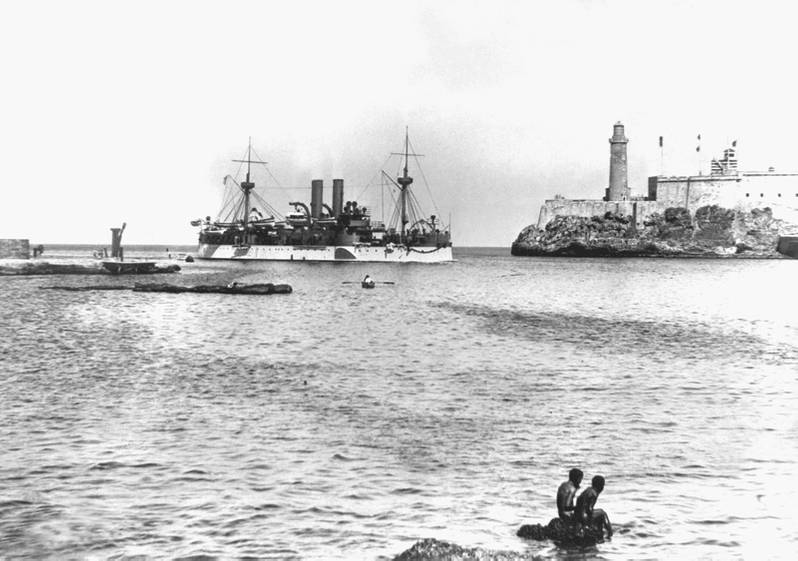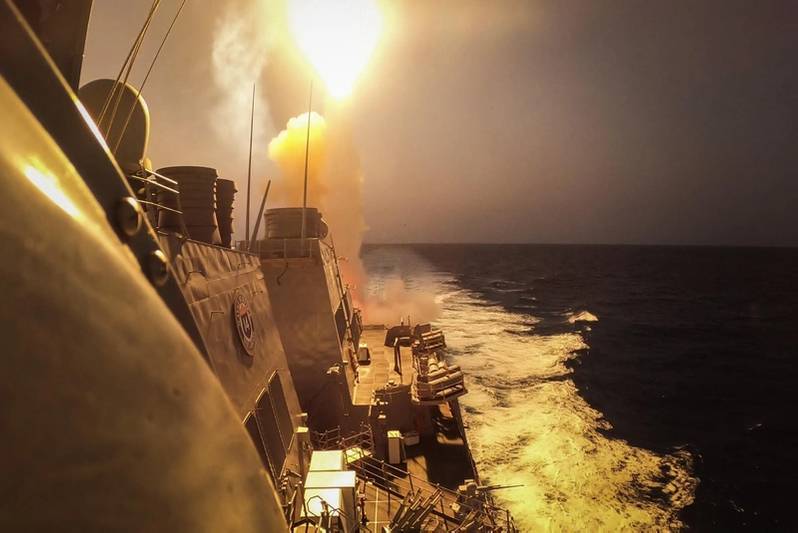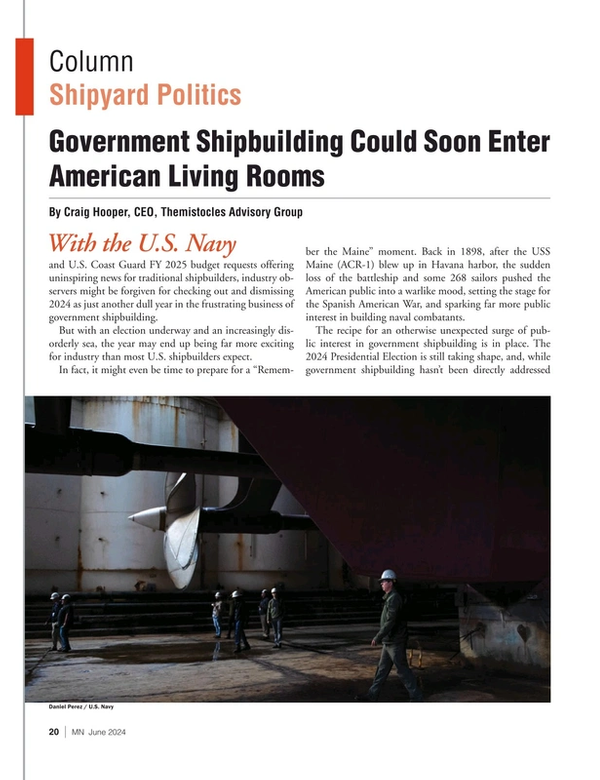
Government Shipbuilding Could Soon Enter American Living Rooms
With the U.S. Navy and U.S. Coast Guard FY 2025 budget requests offering uninspiring news for traditional shipbuilders, industry observers might be forgiven for checking out and dismissing 2024 as just another dull year in the frustrating business of government shipbuilding.
But with an election season underway and an increasingly disorderly sea, the year may end up being far more exciting for industry than most U.S. shipbuilders expect.
In fact, it might even be time to prepare for a “Remember the Maine” moment. Back in 1898, after the USS Maine (ACR-1) blew up in Havana harbor, the sudden loss of the battleship and some 268 sailors pushed the American public into a warlike mood, setting the stage for the Spanish American War, and sparking far more public interest in building naval combatants.
The recipe for an otherwise unexpected surge of public interest in government shipbuilding is in place. The 2024 Presidential Election is still taking shape, and, while government shipbuilding hasn’t been directly addressed on the campaign trail, world events could force politicians to weigh in. By the time the ballots are counted in November 2024, government shipbuilding may well have made it into America’s living rooms.
The dynamics are fascinating. The U.S. Navy is, essentially, waging an undeclared maritime war against Iranian-backed Houthis. In the Mediterranean, U.S. Army troop-sailors are struggling to deploy an aid pier in Gaza. The People’s Republic of China is ramping up maritime pressure across the Asia maritime, but, again, these threats are, to the average citizen—and to the click-bait, traffic-driven general media—remote, out-of-sight, and out-of-mind.
But this could change in an instant. The consequence of a surprise hit on a U.S. military vessel by Houthi drone or a terror attack on U.S. vessels off Gaza is hard to estimate, but, as the explosion of the USS Maine showed back in 1898, an unexpected event can quickly and fundamentally shift American attention towards the maritime.
 USS Maine entering Havana Harbor on January 25, 1898, three weeks before the ship’s destruction. The sudden loss of the battleship and some 268 sailors pushed the American public into a warlike mood, setting the stage for the Spanish American War, and sparking far more public interest in building naval combatants. (Photo: U.S. Department of Defense)
USS Maine entering Havana Harbor on January 25, 1898, three weeks before the ship’s destruction. The sudden loss of the battleship and some 268 sailors pushed the American public into a warlike mood, setting the stage for the Spanish American War, and sparking far more public interest in building naval combatants. (Photo: U.S. Department of Defense)
The same dynamics are in place with China. A sudden event or unexpected change in status quo off Taiwan, the South China Sea, or elsewhere, is likely to accelerate the American public’s growing disillusionment with the direction chosen by the tiny cadre of China’s top leaders, and, potentially, drive political interest in streamlining NAVSEA and resourcing a far larger U.S. fleet.
And, with the Presidential campaign underway, any maritime accident, crisis or challenge can easily feed back into the political race, offering dramatic and otherwise unanticipated consequences for America’s maritime industries.
Another aspect that may drive interest in American shipbuilding is foreign investment. Right now, two major South Korean companies, Hanwha Ocean and HD Hyundai Heavy Industries Co., Ltd., are trying to enter the U.S. government shipbuilding market. In Washington, Navy leaders are extolling the virtues of overseas shipbuilders, and openly discussing opportunities to outsource work. These proposals are already sparking resentment at the waterfront, stirring America’s pride, and they may end up being useful tools for politicians eager to supercharge representation at the ballot box.
Other interesting international efforts—like a simmering effort to explore a wide-ranging collaborative effort to build small icebreakers and ice-ready ships—may drive America’s interest from a more positive direction, highlighting America’s commitment in working with allies in rolling back Polar land-grabs by Russia and Chinese forces.
Congress is getting into the action as well. In early May, Republican Florida congressional representative Mike Waltz (FL-6) released a bipartisan, bicameral National Maritime Strategy Report. The report, supported by Arizona’s democratic Senator Mark Kelly, Senator Marco Rubio (R-FL) and U.S. Congressman John Garamendi (CA-8), “provides a comprehensive vision for planning guidance, strategic objectives, and actionable steps to revitalize our nation’s maritime sector.”
The Congressional effort, a sober collection of smart maritime initiatives, is a “to-do” list for Congress. Normally that’s not something that will move the needle, but, with the potential for a sudden uptick of public interest in the maritime, a Congress armed with a legislative outline—an outline backed by four powerful members—could exploit public outrage to quickly reshape the American maritime.
Right now, aspiring government shipbuilders have an obligation to review their contingency plans and get ready. The opportunity posed by an unexpected outpouring of energized voter interest is not something the industry wants to miss. Facility expansion plans need to be as shovel-ready as possible, option ships need to be priced out and ready, and worker-training programs prepped to absorb a surge of activity or funding.
With America’s political and maritime environments as volatile as they have ever been, any small spark or perceived outrage offers an unprecedented opportunity to push shipbuilding directly into America’s living rooms. To exploit this potential, both parties must put real thought into just who might be the right fit for maritime leadership positions. America may not see the return of another larger-than-life John Lehman-like character, pushing naval expansion at all costs, but America’s decaying maritime position and the state of the U.S. shipbuilding industrial base will be an election-year issue worthy of real and expert attention. So, rather than being just another boring year of little substance in government shipbuilding, 2024 could be the year prepared and ready shipyards get an unexpected windfall.
 The Arleigh Burke-class guided-missile destroyer USS Carney (DDG 64) defeats a combination of Houthi missiles and unmanned aerial vehicles in the Red Sea, Oct. 19, 2023. (Photo: Aaron Lau / U.S. Navy)
The Arleigh Burke-class guided-missile destroyer USS Carney (DDG 64) defeats a combination of Houthi missiles and unmanned aerial vehicles in the Red Sea, Oct. 19, 2023. (Photo: Aaron Lau / U.S. Navy)
Read Government Shipbuilding Could Soon Enter American Living Rooms in Pdf, Flash or Html5 edition of June 2024 Marine News
Other stories from June 2024 issue
Content
- Insights: Richard Schwarz, SAFE Boats International page: 10
- Government Shipbuilding Could Soon Enter American Living Rooms page: 20
- The Evolution of Modern-day Shipbuilding page: 23
- Congress Raises the National Security Alarm on Shipbuilding page: 26
- Autonomous Vessels: Already Working, but Still Under Close Review page: 28
- Inside Project Perfect Storm page: 34
- Deflating Mythology: New Book Unpacks the History Behind the Jones Act page: 38


